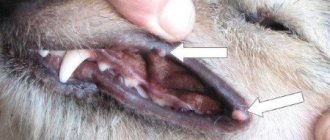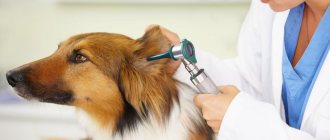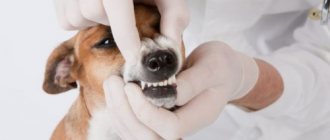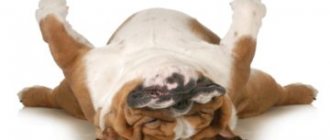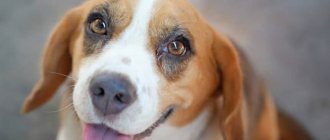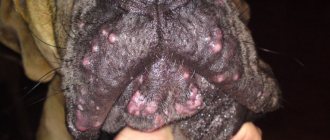Play aggression
The manifestation of this behavior is usually characteristic of puppies and young animals. The emotion of how the baby growls and does not give the toy to the owner provokes the transition of the game into real anger.
To avoid this, it is necessary to always end the comic competition with the victory of the owner. The game “object” must remain with the owner until the next time. This behavior will teach the dog to understand that the toy is the owner’s thing and only he allows him to take it.
Food aggression
Expressed by an aggressive growl at the sight of people or animals approaching a bowl of food. When feeling impunity, the dog can take active actions: bite, continue to growl, hastily grabbing food.
To avoid unpleasant moments during the feeding period, you need to:
- Give food to the animal separately - after eating by household members.
- Do not allow begging - do not throw pieces from the table.
- Introduce a rule - the dog must earn a treat.
- When starting training, be sure to practice until the animal unquestioningly obeys the commands “FU”, “DO NOT”, “SIT” with a bowl filled with food. The dog must understand that the owner allows him to touch the food.
My food and I eat it. Dog aggression related to food.
- Growling while eating when other dogs or people approach or come into view. Can appear at very long distances. — A dog bites if it feels a threat (real or imaginary) of losing its food. — Turns around and actively defends the food or continues to hastily grab it, often dropping it and not ceasing to growl. — A dog may not be aggressive at the sight of its usual food, but aggression increases at the sight of chewed or real bones, scraps of the owner’s food, or treats.
Such aggression is the best indicator of the risk of developing dominance-related aggression.
Aggressive dog behavior associated with food must be stopped as follows:
1. Sit the dog down with the “sit” and “wait” commands.
2. After this, placing a bowl of food next to the dog, command “no” or “fu”, preventing the dog from immediately starting to eat.
3. After a certain pause, having allowed the dog to start eating, give the command “may” or “food”. The dog must understand that it only eats with your permission.
4. Interrupt the dogs' meal with the command “sit” and take away the bowl of food. The dog must allow this to be done without any complaints, growls or lunges.
5. Praise the dog and give him a treat if he follows the command well.
6. If the dog breaks down, does not respond to “fu”, “sit” and shows aggression, pull it away from the food by the leash and remove it. Send the dog to its place.
7. Repeat the exercises until the aggression stops.
To prevent food-related aggression from developing, a number of rules should be followed:
— The dog should eat after all family members have eaten. In a pack, the lowest ranking dog eats last. - Do not encourage begging, do not feed from the table. This can lead to the dog going after everything he wants, thereby becoming dominant. - Don’t give a treat just like that, the dog must earn it.
Territorial aggression
Such aggression manifests itself in the fact that when a dog is kept in a limited area and regardless of the presence of household members nearby, it begins to growl, bark and actively show readiness to lunge at a passerby walking by. When the owner is talking to a stranger, he may continue to actively bark and show aggressive behavior.
To correct such a deviation, when training, you should pay attention to the commands “ALIEN”, “GUARD”, “VOICE”. The dog must understand that the owner allows the protection of the territory.
In no case should empty barking be allowed at passing cars or when the owner is talking, for example, through a fence with a neighbor.
It hurts me, it hurts. Dog aggression due to pain.
— It usually appears in response to manipulation, and in dogs that have already had experience of pain, before manipulation.
- The dog does not necessarily retreat - it can grab the hand with its teeth in an attempt to stop the painful effect or anticipating it.
— Aggression occurs in response to rough play from children or other dogs, especially if the dog is old.
— It often grows and turns into aggression due to fear.
In this case, do not beat the dog for disobedience, do not cause it pain or physical discomfort. Reassure and encourage good behavior. Don't raise your voice, make sure the irritants don't repeat themselves, and stay calm even if the dog bites.
Defensive aggression
As a rule, this type of aggression is typical for trained guard dogs. Being close to a protected person and when strangers approach him, the animal may begin to bark, growl, grab and bite.
In the absence of a threat to the protected person, such a reaction is inadequate. To develop service qualities and avoid problems when walking in crowded places, it is necessary to undergo training with an experienced instructor and early socialization of the dog. But even in this case, the owner should not lose vigilance when the pet is among people.
Fearful aggression towards certain family members
Fear-induced aggression is considered self-defensive aggression directed against a person or animal that the dog is afraid of and is trying to flee or scare away. Another reaction of the dog may be the desire to run away from such people (animals). Fear is a very prominent component of some dogs' behavior. They try to run away, flatten their ears, tuck their tail, and retract their heads whenever a person they are afraid of approaches them. There is no obvious component of fear in the behavior of other dogs. Such dogs behave friendly when approaching a person. Sometimes they even approach him, wagging their tail and looking at him devotedly, but they bite without warning at the slightest movement of the hand.
In the latter case, it seems to suggest that the dog is in a state that psychologists describe as a conflict between approach and avoidance. This means that the dog is under the simultaneous influence of various motivations that encourage the animal, on the one hand, to show friendliness and seek contact, and on the other, to fearfully avoid it. Experiments with animals clearly confirm the correctness of this conclusion. The results of measuring the force expended by a rat to move along a long corridor, reach a food source or move away from the place where an electric shock was received, made it possible to construct a curve of the relationship between approach and avoidance of contact. In principle, rats make significant efforts over long distances to get to food. At the same time, they lack the motivation to move further away from the source of pain, as can be seen from the contact avoidance curve. If both motivations are evoked simultaneously when hungry rats see food in a feeder and at the same time receive an electric shock, it should be assumed that both tendencies, approach and avoidance, are activated.
The theoretical model shows that the animal approaches the box faster from a distance, then gradually decreases speed as it approaches the point at which both motivations are of equal strength. Here the animal will probably stop and move back and forth, as if "competing" motivations are pulling it in both directions at the same time. However, it will then attempt to evade contact as it approaches the combined food and shock source. This corresponds to the actual course of the experiment.
Aggression from fear
If an animal experiences a feeling of fear of people, tries to bite, or shows an unfriendly attitude by growling, then the owner should socialize the pet. For example, if you are afraid of people, you can ask your friends to come up to you on the street and give the dog a treat and pet it. This will calm your pet and give him confidence that there is no danger.
This behavior is typical for animals with an unbalanced psyche, a weak nervous system, and those who have experienced cruel treatment. A medical procedure can also provoke aggression.
Aggression due to fear:
— The dog can bark, growl, grab your hand, while turning over on its back.
- May shake and tremble during and after aggressive actions, bite from behind and run away.
— The dog cowers and tries to run away; driven into a corner, it becomes dangerous.
Reasons for this behavior may include a painful medical procedure, abuse, unreasonable punishment, poor breeding, and raising the dog in an environment with poor experiences and lack of communication. Dogs that have an unbalanced temperament and a weak nervous system almost always bite out of fear.
If your dog exhibits this type of aggression, conduct several training sessions that will help him establish good relationships with others and ensure his own safety. For example, if the dog is afraid of people coming towards you, ask your friends to come up to you and give the dog pieces of something tasty, pet it and calm it down.
From an early age, introduce your puppy to all sorts of objects and phenomena of our daily life. Take it with you everywhere. At the same time, be careful that nothing harms the dog or greatly frightens it. If something frightens your pet, sit down, pet it and calm it down with words. Let him feel your support and confidence.
Aggression due to pain
In response to medical procedures or before them, when the dog has already had a negative experience, it sometimes develops aggression, expressed in growling or biting the owner’s hand. It may also be a response to pain from careless childhood play.
In any situation, such a reaction must be dealt with, the animal must be calmed, but in no case should it be punished.
Cause of sudden aggression in dogs
It should be understood that aggressive behavior in dogs - growling, clicking teeth, biting - means only one thing. This is how the animal expresses its dissatisfaction. The dog seems to be telling its owner: “Stop doing that, I don’t want you to do that!”
This behavior is a request that can occur when you take away a dog's favorite toy or try to trim its nails. And this is quite natural; you need to work with it so that the animal stops being afraid of hygiene procedures or showing a possessive instinct.
When a dog is afraid of the owner’s outstretched hand, reacts inappropriately to those everyday situations that previously did not cause him problems - this is where you need to show full attention and be vigilant.
Expert research shows that sudden aggression in a dog, especially towards its owner, is associated with the pain the animal experiences.
Unfortunately, very painful manifestations of various diseases in dogs can go unnoticed by the owner for a long time. Animals cannot complain of joint pain, broken spine, toothache, ear inflammation, etc. The painful symptoms of such diseases and hidden injuries are outwardly invisible, but dangerous to the health of the pet.
Predator aggression
Dogs with a highly developed hunting instinct may experience a pursuit race, for example, when they see running children, passing cyclists, or small mammals (birds) appearing in its field of vision. The animal is dangerous at such moments.
The behavior can only be prevented by taking your dog through an obedience course. The commands “TO ME” and “LIE” must be practiced until unquestioningly executed.
It is advisable to start practicing commands while playing with any object, using a long leash. This will help in managing the dog and establish the owner as a leader.
Possessive aggression or “I won’t give up what’s mine.”
— The dog does not give away toys and other objects, including those stolen during play with a partner (human or animal).
-Can bring an item to play with and then growl if someone tries to take it.
— The dog protects an object that it observes from a distance.
You should remember and teach your puppy that toys or other objects belong to you, not your dog, and you allow the dog to use them.
Manifestation of defensive aggression:
— Aimed at protecting owners from other people or dogs.
— One person can be selected as the object of protection and protection.
— The dog stands between the protected person and others.
— The dog barks, growls, grabs, bites; manifestations of aggression usually intensify when the enemy approaches the protected object.
- The reaction can be provoked by quick movements and hugs.
— In the absence of a protected person, aggression does not manifest itself.

